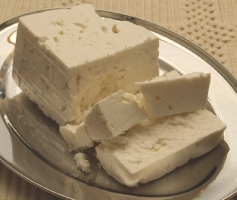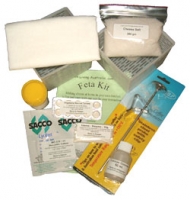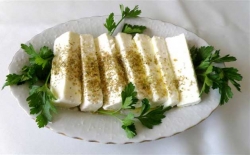Product Message
Feta Cheese Kit - Makes 24 batches of cheese
Tangy feta is within grasp with this make at home feta cheese making kit.
| Retail Price: | $75.00 |
| Qty: |
|
Product Information
The Feta Kit is an ideal beginner cheese kit, perfect for those with no cheese making experience.
This kit contains enough ingredients to make up to 24 batches of Feta, using 3 litres of milk each time and includes:
Instruction Booklet
200 mm Dairy Thermometer
Two "Feta" Baskets
Loose Weave Cheese Making Cloth
Calcium Chloride
Rennet Tablets
MO 030 Mesophilic Starter Culture
Lipase
Cheese Salt
Sterile Jar
Please note: We recommend buying a set of measuring spoons that have designed specifically for cheese making. These can be added as a separate product. Please note that when heating the milk and stirring, all must be done gradually and very slowly and gently. That way you will not scold the pan and burn the milk.
The EXPRESS POST cost will be added at checkout when asked to be sent by Aust Post.
Question: My cultures have arrived, but the cooler blocks have melted, and everything feels warm, is this OK ?
Yes !! Just store the items "as advised" as soon as possible.
To be honest, most cheese making ingredients and yoghurt cultures are shipped to us from overseas, without any cooling, and we just store the items correctly, once they get to us.
What we wish to avoid is anyone getting their yoghurt or cheese cultures, and storing them in the pantry for many months, without even knowing that they needed to be put in the fridge or freezer.
Perhaps we are "overcompensating" with cooler blocks, and labels all over the place, but we do know someone who kept an unopened cheese kit in a hot pantry for two years.
Question: How do I store the culture, and other cheese making ingredients ?
The dry items like cultures and rennet tablets should be stored in a freezer, and liquid items like liquid rennet should be stored in a refrigerator.
We supply sterile jars free with the culture sachets, and these are for the storage of the cultures once the sachets are opened. We recommend not to open the sachet until you are about to make your first cheese.
When opening the sachet of culture we recommend bringing it to room temperature first. This will reduce the effect of the condensation causing some of the culture being stuck to the inside of the sachet. Cut all the way across the top of the sachet, then concertina it, and pour the culture into the sterile jar supplied.
Please be carefull to close your jar properly, to keep the moisture out while it is in the freezer.
Question: How do I test my rennet ?
Heat one cup of milk to 32C, and if using homogenised milk, add 2 drops of Calcium Chloride. (Do not add citric acid.)
Dissolve 1/4 rennet tablet (or 1/4 tsp. liquid rennet) in 225ml of cool water and stir well. From this diluted rennet take 2 tablespoons and add it to the milk at 32C. Stir gently from the bottom to the top for 30 seconds.
If the rennet is working, the milk surface will begin to firm or form a slight film after two minutes. After six minutes, it will have formed a curd that will hold a knife cut.
Question: How much culture do I use ?
Our Mini Measuring Spoons give a pretty accurate dose measurement.
With our MOT 092 Thermophilic and MO 030 Mesophilic cultures the sachet is suitable for 100 litres of milk, and will give twelve standard doses, if following our instructions. A heaped “Smidgen” (1/32nd tspn) will give twelve doses from these sachets.
With our MO 036 Mesophilic culture the sachet is suitable for 1000 litres of milk, and will give over 100 doses, if following our instructions. A heaped "Drop" (1/64th tspn) will give approximately 100 doses from this sachet.
It is a good idea to record how many doses you get from your culture to confirm that you are measuring correctly.
Question: How do I know if my cheese is dry enough to wax ?
Once the cheese has been pressed it is removed form the mould and set out to dry on a wooden cheese board. Drying can take several days, during which time the cheese is turned to ensure even drying. When “dry” the cheese should both appear, and feel dry to the touch.
Question: What do I do about mold on my cheese, while drying?
Because of the high humidity in some parts of Australia, drying can sometimes take more than just a "few days", so there is an increased chance of mould spores in the air landing on your cheese. To remove the mould simply wipe it off with a vinegar moistened cloth.
Question: What do I do about mold on my cheese, under the wax ?
So when removing the wax, you find some mould has grown on your cheese ... just cut it of and enjoy the rest of your cheese adventure.
Question: I have a "Starter Kit", but I want to make more advanced cheeses, where do I get the instructions ?
You can get away with making the more simple cheeses in our starter kit, with the limited instructions supplied ... but our kit is just that, a "starter kit" ... as you move onto more complex cheeses, a much greater depth of knowledge is needed, such as can be found in the Ricki Carroll book, "Home Cheese Making" .....
Question: My cheese has a bitter taste. What could have gone wrong ?
Too much rennet can give the cheese a bitter taste. Reduce the amount of rennet in your next attempt at this cheese.
Contamination due to poor hygiene can cause a bitter taste. This can happen to the best of us so be sure your working environment is clean and that you have sterilized all your utensils. If you are using raw milk, pasteurise it before making your cheese to ensure that there are no unwanted pathogens in your milk.
Your milk became to acidic. This is caused by the milk over ripening once you have added your culture. Over ripening is cased by adding too much culture or leaving it to ripen for too long. Be careful with your measuring of the culture and watch your timing.
Double boilers are expensive, what else can I use?
Large stockpots come from a local hardware store, with the smaller two suitable for smaller milk batches, and these two suitable for up to 10 or even 12 litres.










